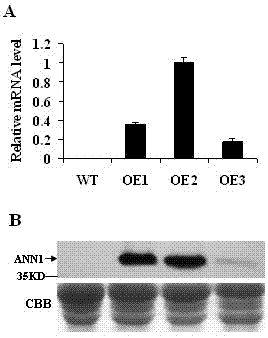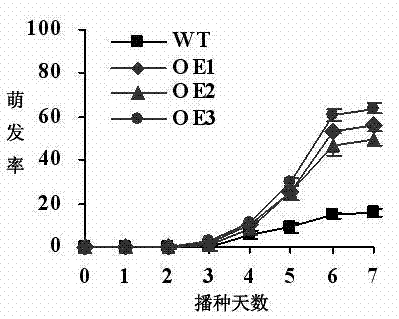Lotus annexin and expression vector and application thereof
A technology for expressing vectors and annexins, applied in the fields of molecular biology and plant genetic engineering, can solve the problems of no annexins and heat resistance of seeds, achieve broad application space and market prospects, improve heat resistance and Vitality, the effect of improving germination vitality
- Summary
- Abstract
- Description
- Claims
- Application Information
AI Technical Summary
Problems solved by technology
Method used
Image
Examples
Embodiment 1
[0031] Example 1 Lotus annexin gene NnANN1 clone
[0032] (1) Preparation of hypocotyls of lotus seeds: Harvest the lotus seeds at the late stage of development and strip off the hypocotyls;
[0033] (2) Extraction of total RNA: Total RNA was extracted using Trizol product from Invitrogen;
[0034] (3) cDNA library construction: the library was constructed using SMART cDNA library construction kit from Clontech;
[0035] (4) EST sequencing: The obtained positive monoclonal bacterial liquid is used as a sequencing sample, and Shanghai Boya Biotechnology Co., Ltd. is entrusted to sequence the positive monoclonal after PCR verification with a 3730 sequencer;
[0036] (5) Homologous search: BLAST tool was used to search the homologous gene of the obtained EST sequence in GenBank, and the obtained gene was confirmed to be the lotus annexin gene.
Embodiment 2
[0037] Example 2 Construction of Plant Expression Vectors
[0038] (1) Gene fragment cloning: Using the lotus cDNA library described in Example 1 as a template, PCR cloning was performed to obtain enzyme cleavage sites Sma I and Sac PCR fragment of I. The PCR primers are as follows, the underlined part is the restriction site:
[0039] Forward primer: SEQ ID NO:3: 5′-TCC CCCGGG ATGGCTACCATCACAGTCCCTG-3';
[0040] Reverse primer: SEQ ID NO:4: 5'-CTG GAGCTC TCACAGCTCTTCGCACCCCAGT-3';
[0041] The PCR reaction system is: 2 μl lotus cDNA library, 6 μl dNTP (2.5 mM), 1.5 μl forward primer (10 μM), 1.5 μl reverse primer (10 μM), 5 μl 10×PCR buffer, 1 μl EX Taq enzyme (product of Takara Company), and deionized water was finally added to make the total system 50 μl. The reaction conditions of PCR are: 94°C for 3 minutes; then enter the following cycle: 94°C for 30 seconds, 58°C for 30 seconds, 72°C for 30 seconds, a total of 30 cycles; finally 72°C for 7 minutes.
[004...
Embodiment 3
[0047] Example 3 Genetic Transformation of Arabidopsis
[0048] 1. Pre-treatment of Arabidopsis transformation
[0049] When the main moss grows to 5-6cm, cut off the entire inflorescence at the base of the inflorescence, and remove the top advantage. After 1 week, 4-6 new side mosses will grow on the axillary buds, and the side mosses will form flower buds and partially bloom. Or when 1-2 siliques are formed, they can be used for transformation, and the grown siliques need to be cut off before transformation. The day before transformation, the plants were well watered and covered with a plastic bag to maintain a high humidity environment.
[0050] 2. Preparation of Infection Medium
[0051] The composition of the dipping medium used for soaking Arabidopsis flocs is 1 / 2MS medium containing 5% sucrose, pH=5.8 (adjusted with KOH), autoclaved. When using, add 0.02%-0.05% surfactant Silwet L-77 or surfactant Tween-20 (tween-20), and the operation needs to be gentle.
[0052]...
PUM
 Login to View More
Login to View More Abstract
Description
Claims
Application Information
 Login to View More
Login to View More - R&D
- Intellectual Property
- Life Sciences
- Materials
- Tech Scout
- Unparalleled Data Quality
- Higher Quality Content
- 60% Fewer Hallucinations
Browse by: Latest US Patents, China's latest patents, Technical Efficacy Thesaurus, Application Domain, Technology Topic, Popular Technical Reports.
© 2025 PatSnap. All rights reserved.Legal|Privacy policy|Modern Slavery Act Transparency Statement|Sitemap|About US| Contact US: help@patsnap.com



